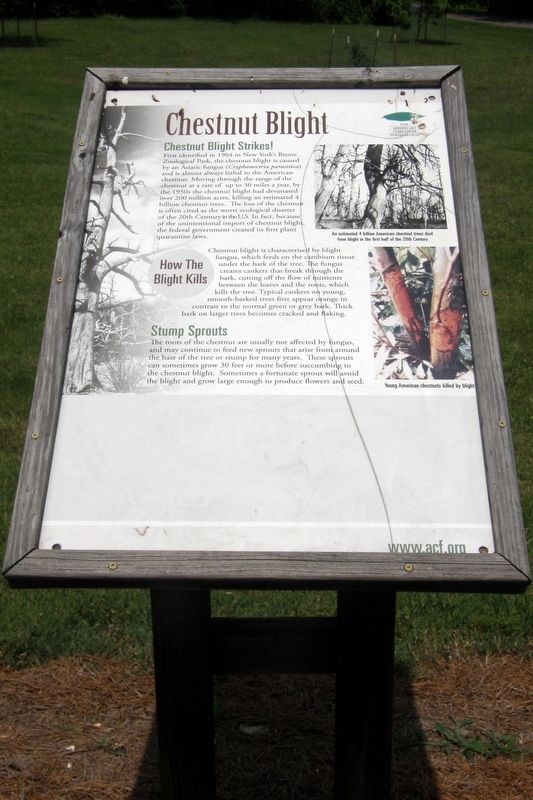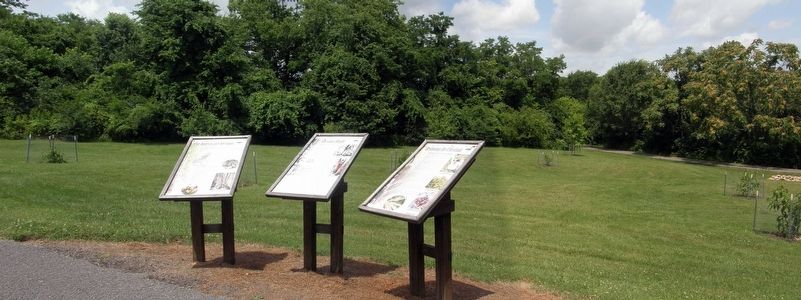Franklin in Williamson County, Tennessee — The American South (East South Central)
Chestnut Blight
Chestnut Blight Strikes!
First identified in 1904 in New York’s Bronx Zoological Park, the chestnut blight is caused by an Asiatic fungus (Cryphonectria parasitica) and is almost always lethal to the American chestnut. Moving through the range of the chestnut at a rate of up to 30 miles a year, by the 1950s the chestnut blight had devastated over 200 million acres, killing an estimated 4 billion chestnut trees. The loss of the chestnut is often cited as the worst ecological disaster of the 20th century in the U.S. In fact, because of the unintentional import of chestnut blight, the federal government created the first plant quarantine laws.
How the Blight Kills
Chestnut blight is characterized by blight fungus, which feeds on the cambium tissue under the bark of the tree. The fungus creates cankers that break through the bark, cutting off the flow of nutrients between the leaves and the roots, which kills the tree. Typical cankers on young, smooth-barked trees first appear orange in contrast to the normal green of grey bark. Thick bark on larger trees become cracked and flaking.
Stump Roots
The roots of the chestnut are usually not affected by fungus, and may continue to feed new sprouts that arise from around the base of the tree or stump for many years. These sprouts can sometimes grow 30 feet or more before succumbing to the chestnut blight. Sometimes a fortunate sprout will avoid the blight and grow large enough to produce flowers and seed.
Erected by The American Chestnut Foundation.
Topics. This historical marker is listed in these topic lists: Environment • Horticulture & Forestry • Science & Medicine. A significant historical year for this entry is 1904.
Location. 35° 53.425′ N, 86° 52.747′ W. Marker is in Franklin, Tennessee, in Williamson County. Marker can be reached from Columbia Avenue (U.S. 31) 0.1 miles south of Hillview Lane, on the right when traveling south. Touch for map. Marker is at or near this postal address: 1101 Hillview Lane, Franklin TN 37064, United States of America. Touch for directions.
Other nearby markers. At least 8 other markers are within walking distance of this marker. Restoring the Chestnut (here, next to this marker); The American Chestnut (here, next to this marker); Protecting Our Historic Resources (about 400 feet away, measured in a direct line); Samuel Winstead (1778-1851) (about 400 feet away); Welcome to Winstead Hill Park (about 400 feet away); Winstead Hill (about 600 feet away); Brigadier General Hiram B. Granbury (about 600 feet away); States Rights Gist (about 600 feet away). Touch for a list and map of all markers in Franklin.
Also see . . . The American Chestnut Foundation homepage.
(Submitted on December 27, 2019, by Larry Gertner of New York, New York.)
Credits. This page was last revised on December 27, 2019. It was originally submitted on December 27, 2019, by Larry Gertner of New York, New York. This page has been viewed 157 times since then and 6 times this year. Photos: 1, 2, 3. submitted on December 27, 2019, by Larry Gertner of New York, New York. • Devry Becker Jones was the editor who published this page.


